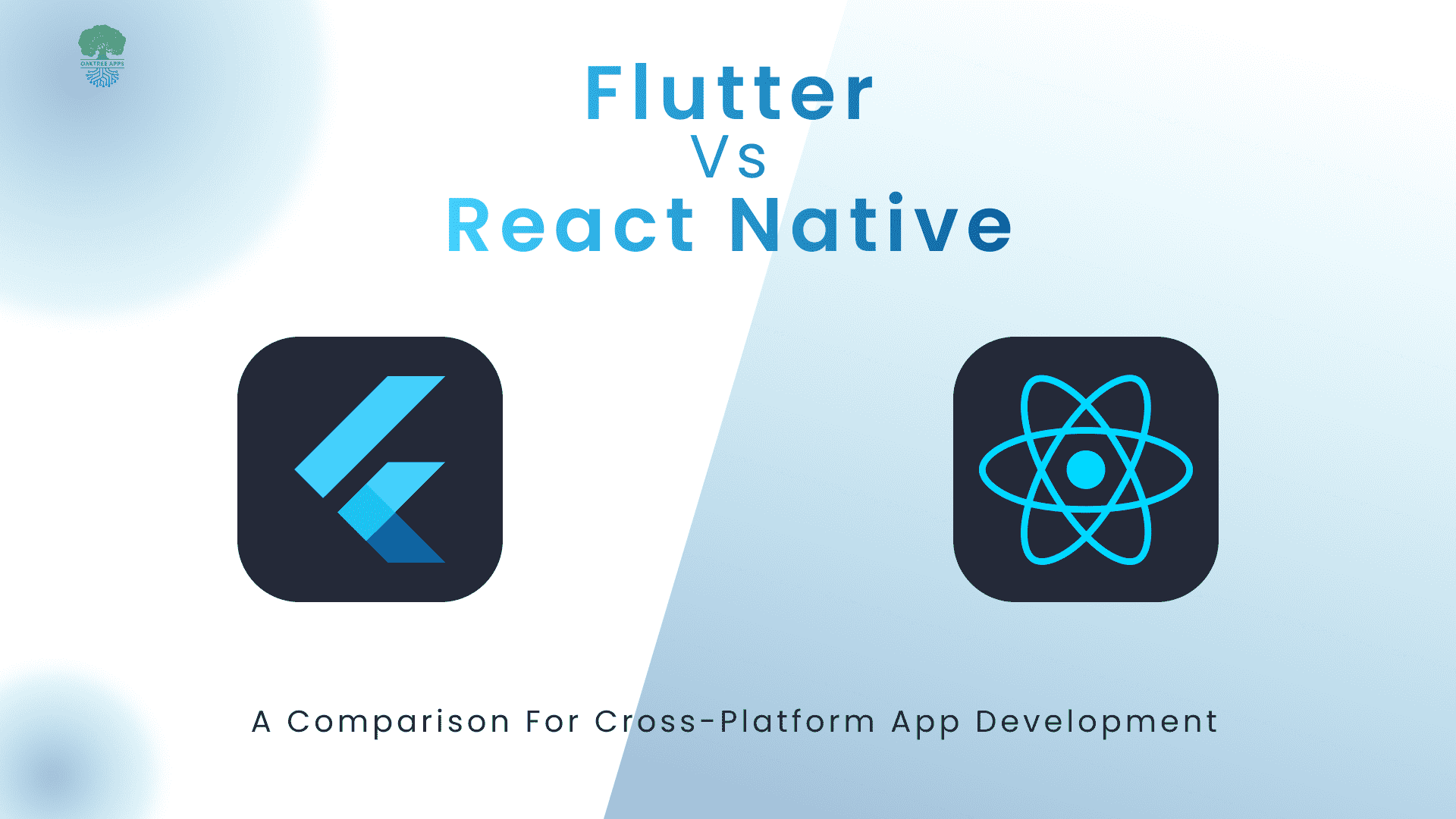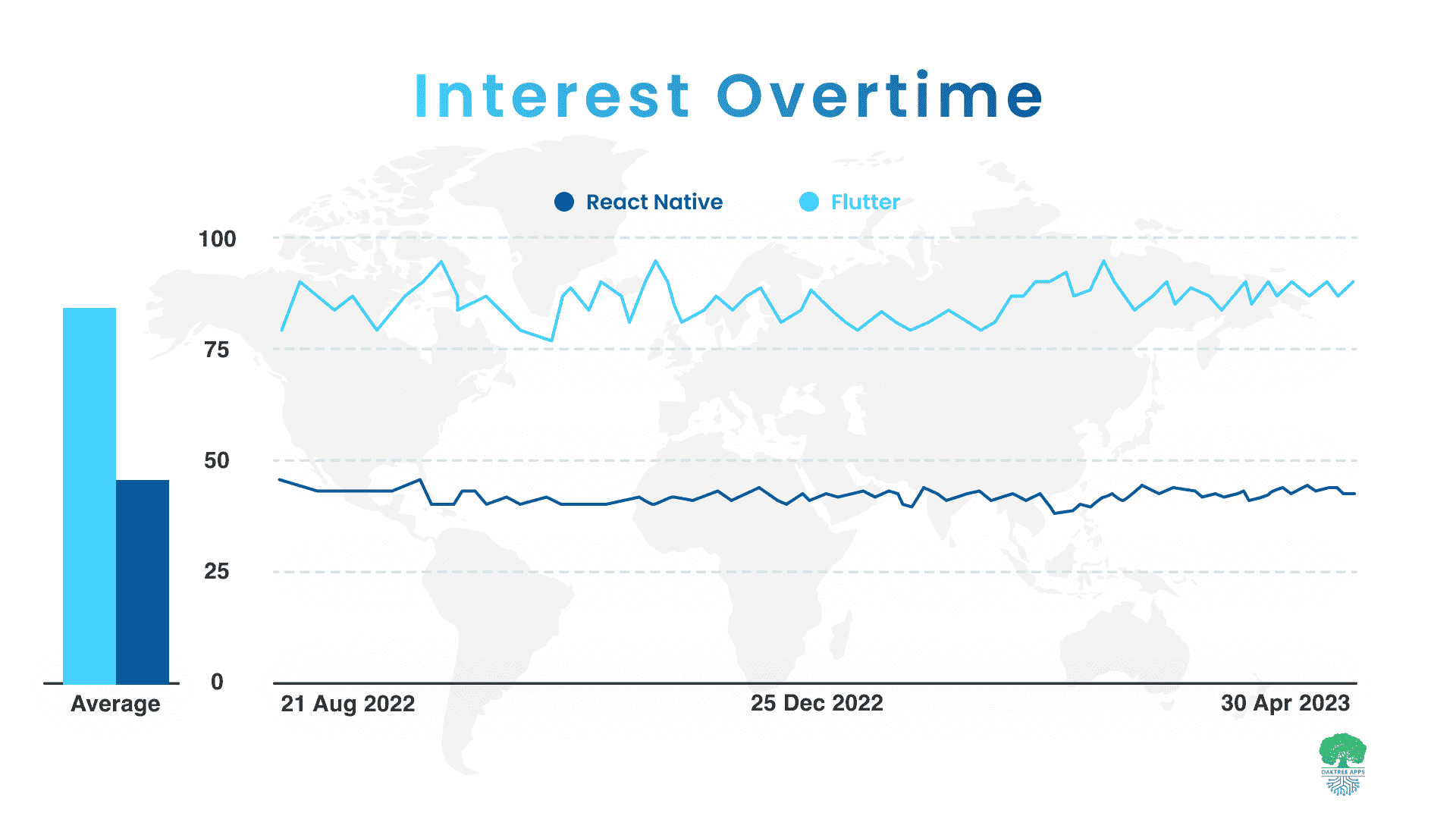Aug 10 2023

In our tech-driven world, where mobile devices have become integral, the art of crafting mobile applications has surged forward. In a period dominated by mobile apps, the essentiality to engage with users across different platforms is unquestionable. Enter Flutter and React Native: two giants vying for the cross-platform throne.
In this face-off, we'll delve into their features and performance, arming you with insights. Whether you're an explorer of code or a business striving for app excellence, this guide equips you to tackle the Flutter vs. React Native conundrum.
Flutter: Unveiling the Canvas of Possibilities
Flutter, the brainchild of Google, introduces a reactive framework and the Dart programming language. It flaunts a wealth of customizable widgets, presenting a unified codebase across iOS, Android, web, and desktop. The "Hot Reload" feature expedites iterations, while its expressive UI components nurture imaginative design.
Yet, the burgeoning community and narrower native module options in Flutter development deserve attention. Its streamlined development and visual finesse make it a standout for startups. As we delve into React Native, remember how Flutter weaves uniformity into the fabric of cross-platform enchantment.
React Native: Bridging with JavaScript Brilliance
React Native, born on Facebook, leverages JavaScript for cross-platform prowess. Its modular architecture and vast community grant access to a library of pre-built components. "Fast Refresh" boosts developer efficiency, while native module integration enriches functionality.
However, performance intricacies, occasional platform inconsistencies, and dependency on third-party libraries can pose challenges. React Native shines for projects with complex logic and integration requirements. It's a versatile tool harnessing JavaScript's ubiquity yet demands finesse in navigating its ecosystem. As we weigh both contenders, React Native emerges as the bridge between versatile coding and native app aspirations.

Development Language and Environment: Dart vs JavaScript
When the topic is about building cross-platform apps using either Flutter or React Native, the programming language is the key to success. While the Flutter framework relies on Dart, a programming language by Google well-reputed for its performance and is designed specifically for creating user experience. Although Dart may not be so familiar to some developers, the strong typing and asynchronous capabilities streamline cross-platform development in Flutter.
But React Native employs JavaScript, common in web development, ensuring an approachable learning curve and broad contributor base. Yet, JavaScript's dynamic typing can yield runtime errors, necessitating vigilant testing.
Balancing performance and familiarity in cross-platform app development involves a critical choice between Dart and JavaScript. This decision relies on team expertise and the need for a cohesive cross-platform experience.
UI Component and Customization: Widgets vs Components
In the Flutter framework, the main UI elements are widgets. These customizable building blocks ensure a uniform appearance across platforms, facilitating efficient design iterations. In contrast, React Native employs native components, tapping into each platform's inherent UI elements for an authentic feel.
Flutter’s widgets offer greater flexibility in design while React Native’s components seamlessly align with individual platform aesthetics. The choice depends on whether versatility or native alignment holds precedence in your cross-platform app development vision.
Performance and Speed: Flutter's Optimized Engine
Flutter’s specialty lies in its optimized graphics engine that directly renders UI components. This leads to swift performance and consistent behavior across multiple platforms. On the other hand, React Native utilizes a bridge to communicate with native modules which can exhibit occasional lags due to this intermediary communication. Flutter framework’s streamlined process and direct rendering give it an edge over React Native in terms of speed and performance, especially for visually intricate apps.
Third-party Libraries and Plugins: Extending Functionality
Both Flutter and React Native frameworks offer a diverse range of third-party libraries and plugins to augment app functionality. Flutter's repository benefits from Dart's type system, ensuring smooth integration. React Native taps into the vast JavaScript ecosystem, providing a wider selection. Flutter's ecosystem has a narrower focus, whereas React Native offers a broader range to accommodate diverse requirements.
Community and Documentation: Guiding the Way
When it comes to community support and documentation for cross-platform app development, both Flutter and React Native offer unique advantages. Flutter's community, although smaller, is rapidly expanding with Google's backing, fostering an environment of innovation.
React Native, with its larger and established community, provides a vast knowledge base and a plethora of resources. This ensures a wider pool of expertise to draw from and stable solutions.
Both frameworks provide thorough official documentation for developers of all levels. When it comes to cross-platform development, the decision depends on whether you lean towards Flutter's innovation or React Native's expertise, both contributing to the landscape.
Development Efficiency: Speeding Up the Process
Efficiency in cross-platform development takes center stage with Flutter and React Native. Flutter's "Hot Reload" feature allows instantaneous code updates, expediting debugging and UI tweaks. Its single codebase reduces development efforts, as changes reflect uniformly across platforms. React Native's "Fast Refresh" similarly accelerates the iteration cycle. While both frameworks enhance development speed, Flutter's consistency across platforms and instantaneous updates offer a remarkable edge. Consider your project's complexity and the convenience of uniformity when choosing between React Native's familiarity and Flutter's streamlined, real-time iteration for efficient cross-platform development.
Platform Support: Navigating Multi-Platform Terrain
Platform compatibility plays a pivotal role when diving into cross-platform app development. Flutter distinguishes itself by boasting robust adaptability across iOS, Android, web, and desktop platforms, providing an exhaustive toolkit catering to diverse audiences.
Conversely, React Native's primary concentration lies within iOS and Android, although ongoing community efforts aim to extend its reach. If your goal involves fluidly bridging across multiple platforms, Flutter's comprehensive inclusivity streamlines development.
Yet, if your prime objective revolves around catering exclusively to the mobile domain, React Native's precision-oriented approach could potentially serve your cross-platform aspirations more adeptly.
Cost Considerations: Flutter vs React Native
In cross-platform app development, the cost can be a challenging area for many startups. With a streamlined approach, a single codebase, and an efficient "hot reload" feature, Flutter development cost can potentially be at the lower end as well as the development time. On the other hand, React Native's reliance on native modules for platform-specific features might introduce complexities, affecting the overall cost. However, the actual cost impact depends on various project-specific factors like complexity, team expertise, and app requirements.
Explore the Cost Factors of Flutter App Development
Get insights from our experts to make an informed decision.
Talk to Flutter ExpertsReal-World Cross-Platform Triumphs
Analyzing practical use cases offers a tangible perspective on how both the Flutter and React Native frameworks excel in the context of cross-platform app development. Noteworthy corporations including Alibaba, Google Ads, and Tencent have harnessed Flutter's seamless UI and efficient hot reload for agile iterations.
Conversely, React Native boasts adoption by industry leaders such as Facebook, Instagram, and Airbnb, leveraging its JavaScript proficiency. These real-world illustrations shed light on the unique merits of each framework within tangible cross-platform applications.
Quick Comparison: Flutter vs React Native for Cross-Platform App
| Aspect | Flutter | React Native |
|---|---|---|
| Development Language | Dart | JavaScript |
| UI Component | Customizable widgets | Native components |
| Performance | Optimized graphics engine | Bridge communication |
| Third-party Libraries | Dart's package repository | JavaScript ecosystem |
| Community Support | Growing community, Google's backing | Established, wide community |
| Platform Coverage | iOS, Android, web, desktop | Primarily iOS, Android, and community extensions |
| Development Efficiency | "Hot Reload" for real-time changes | "Fast Refresh" for rapid iterations |
| Use Cases | Alibaba, Google Ads, and Tencent | Facebook, Instagram, and Airbnb |
Flutter for Cross-Platform App Development: Advantages and Disadvantages
| Advantages | Disadvantages |
|---|---|
| Single codebase for multiple platforms | Smaller community compared to React Native |
| Hot Reload for real-time changes | Limited availability of third-party libraries |
| Consistent UI across platforms | Requires learning Dart programming language |
| Rich set of customizable widgets | Larger app size due to embedded Dart runtime |
| Optimized graphics engine for performance | Limited platform-specific functionality |
React Native for Cross-Platform App Development: Advantages and Disadvantages
| Advantages | Disadvantages |
|---|---|
| Wide community and resources | Performance can be affected by bridge communication |
| A large pool of third-party libraries | Platform-specific UI might require custom modules |
| Utilizes JavaScript, a widely known language | May need to rely on native modules for complex features |
| Established in the industry with well-known companies using it | Occasional platform inconsistencies |
| Supports iOS and Android as primary platforms | Can be challenging to achieve pixel-perfect UI |
Elevate Your Vision with Flutter App Development
Let our Flutter experts bring your app idea to life
Start Building with UsThe Final Thoughts
Within the dynamic domain of cross-platform app development, Flutter stands out as an ideal choice for startups and entrepreneurs seeking to create impactful solutions. It offers a unified codebase, facilitates rapid iteration with its "Hot Reload" feature, and boasts expressive UI components. Flutter for cross-platform app development provides a robust framework that empowers creators with efficiency and versatility.
React Native, with a strong JavaScript foundation, bridges native aspirations, and intricate logic, boasting a vast community and third-party libraries. The choice hinges on startups' innovation-driven vision (Flutter) or reliance on proven methodologies (React Native), both harnessing the single codebase advantage to craft compelling multi-platform mobile experiences.

